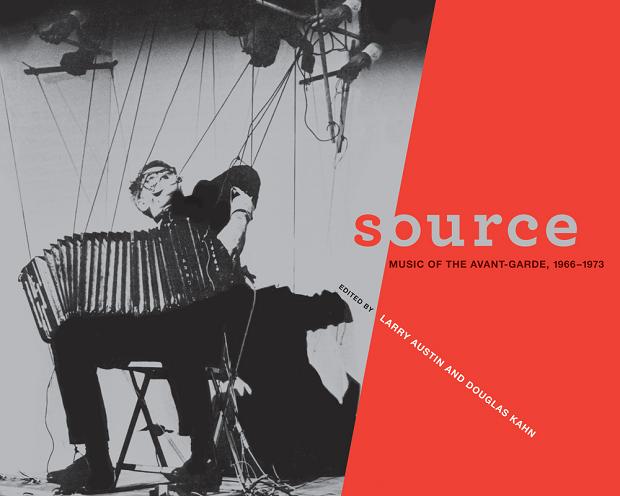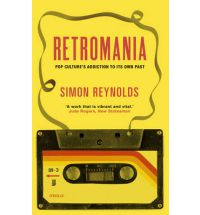Where’s the (musical) avant garde? Unknown Spins
Music & Dance, New in Ceasefire, Unknown Spins - Posted on Wednesday, February 29, 2012 4:09 - 0 Comments

Source: Music of the Avant-Garde, 1966-1973, ed. Larry Austin and Douglas Kahn (University of California Press, 2011, £24.95)
Retromania: Pop Culture’s Addiction To Its Own Past, Simon Reynolds (Faber, 2011, £10.99)
Over the course of its eleven issues, the journal Source served as a new forum for the expression and dissemination of experimental music, poetry and art. This space was made possible, in part, by the wider cultural milieux in which Source was published: a well-supported music department at UC Davis, where Source began; an emergent international counterculture that was politically engaged, particularly with the ongoing war in Vietnam; and an entrepreneurial publishing environment that could still, just, facilitate large-scale independent distribution. This new edition of scores and articles Utaken from the journal comes at a time when public funding for experimental art is shrinking, pen-and-ink publishing is in decline, and the pop and avant-garde worlds seem further and further apart. The cultural equivalent of The Beatles putting Stockhausen on the cover of Sergeant Pepper’s seems unimaginable now. Some token Steve Reich once a year at the Proms is now as close as modern composition gets to wider public exposure.
In this light, the questions that have always been asked of experimental art practice seem more pressing than ever. Is it fundamentally elitist? More concerned with novelty of form than depth of content? A secret language that demands learning, but offers scant reward for so doing? Is it, in short, any fun at all? At first glance, the odds of such an argument being refuted by returning to the material presented in Source look slim. It bristles with charts and diagrams; and the first issue signs off by conducting an interview with the go-to grumpy old man of ‘difficult’ music, Karlheinz Stockhausen. In any case, how much fun can just reading about clangs, bangs, feral bellows and mysterious scraping sounds ever be without actually hearing them?
With perseverance, however – particularly when the text is perused alongside Youtube and Ubuweb – the characterisation of the avant-garde in this period as austere or willfully obscure begins to look unfair. Who can resist Nelson Howe’s enthusiastic machine-gunning of the score for ‘Symphony 585’ (sadly not fully reproduced here, though we do get a slightly alarming photo of the composer demonstrating the procedure)? Or Stanley Lunetta’s instructions for ‘playing’ David Tudor (“if you are not David Tudor, you must study hard”), or Nam June Paik’s characteristically daft ‘Young Penis Symphony,’ definitely operating at the puerile end of the Fluxus spectrum? Such work certainly serves to deflate some of the more academic work on show here, and some of its more curmudgeonly practitioners (though there’s a particularly gruelling one-two of contributions from Anthony Braxton and Cornelius Cardew in Issue 10). But then Source and its contributors always maintained a playful tension with the peripheries of both academia and the mainstream; David Behrman used his A&R contacts at Columbia Records to cut LPs for the magazine on the cheap, Folke Rabe worked in the state-run Swedish Radio studios to compose patient, formally staggering drone. And, lest we forget, John Cage used his residency at the New School of Social Research to teach an amateur mushroom-collecting class. Suddenly, we seem a long way from Schoenberg.
Some of the most straightforwardly beautiful material here, meanwhile, comes from outside the US, particularly from those working in the text-sound realm. England’s Bob Cobbing contributes the stunning poem ‘Chamber Music,’ while Åke Hodell’s furious anti-colonial piece ‘Mr. Smith in Rhodesia’ is another work particularly worth hearing in conjunction with the printed text.‘MARVELLOUS APHORISMS ARE SCATTERED RICHLY THROUGHOUT THESE PAGES’, reads Gavin Bryars’ score for ‘Verbal Pieces’, and he’s quite right; this is work that’s funny, and moving, sometimes difficult but often rewarding.
Uncovering the riches that Bryars describes demands a bit of effort from the listener. The work of listening and thinking hard about the material presented in Source is, however, aided by a number of tools uniquely available to our current technological and cultural situation. An inquisitive listener in 1967 may have seen Stockhausen on the cover of Sgt. Pepper’s, and then adventurously bought an LP on CBS or Deutsche Gramophon; moving from that point to submersing oneself in the soundworld covered by Source, however, required not only dedication and considerable investment, but to an extent also being in the right place at the right time. In 2011, even the vaguest interest in experimental music can be fulfilled by the entire corpus of Stockhausen, or any of the other composers featured in Source, at the click of a mouse. What was once a curious, exploratory path through related musics is now a horizontal plane; or, more accurately, an onrushing wave that threatens to submerge even the most attentive listener.
This is the situation that Simon Reynolds describes and endeavours to account for in Retromania. Some of the ideas presented here will be familiar to readers of his consistently thought-provoking Blissblog; as with his previous books, Reynolds writing style, amiably spiked as it is with smatterings of critical theory, feels like reading a bright and enthused student journalist in the best possible way. Reynolds’ basic thesis is that the emergence of new media has facilitated a shift away from ‘the new’ as the direction of attention across pop culture, to a reorientation towards what has gone before. This is true both in terms of re-consuming the past, in the case of whole-album reunion tours and endlessly reissued records, and taking previous cultural milieux as the conscious or unconscious ur-text for future artistic endeavours; see Reynolds’ hauntological favourites The Focus Group and Mordant Music, or their considerably less arch transatlantic brothers-in-hypnagogia (The Skaters, Oneohtrix Point Never et al). When he hits his stride, Reynolds’ unpacking of these phenomena is consistently stimulating. It’s hardly a new point that we all download more music than we’re able to listen to, or even hear; and while ‘franticity’ is perhaps an unwieldy way of putting it, the tetchy, obsessive-compulsive urge to organise the sheer deluge of content will be familiar to all chronic downloaders. Similarly, the familiar complaint that this glut leads to a lack of commitment to, or investment in, listening has important implications for the work covered in Source. There’s effort required, yes; but, more importantly, there’s a narrative path, from listening hard to one leftfield record to buying another, weirder one, that is lost when everything’s available all the time.
Reynolds is particularly good on explicating this kind of rhizomatic paralysis (a term he might well have used, but doesn’t). One of the most important corollaries, for this column at least, is the way in which ‘record-collector rock’ serves as a critical lifeboat on the sea of superfluity; by assembling an economy of cool that both reclaims a hierarchy of good records and bad ones, and positions the artist within that economy (normally at the bottom, paying tribute to one’s heroes). ‘Where financiers speculated in futures, bands of this kind speculated in pasts,’ says Reynolds. This goes further than just the newest NME duds dumbly aping the Rolling Stones; Reynolds, rightly, identifies the music of Sonic Youth and Stereolab as ‘switching centres’ where influences interlock, are carefully curated and exhibited. This is, in some ways, a Good Thing; in the pre-internet era, I dimly remember moving onto Pere Ubu from Bad Moon Rising, and finding about Neu! via Transient Random-Noise Bursts…, discoveries which may otherwise never have happened. Taken to its logical conclusion, however, what is the future of a music constituted from different combinations of pasts? Reynolds makes some interesting comparisons with the unending (and in many ways market-driven) archival recombinations of the fashion world: contemporary music ‘hasn’t quite reached the point of utterly arbitrary oscillations of period style, but it’s getting there.’
The book runs out of steam somewhat somewhere around the halfway mark, with a potted history of various revival movements and rock nostalgias, but picks up the pace in the closing chapters. This is particularly true of Reynolds’ contrast between the vacuity of the mashup (an ‘indistinct, digital-data-grey pulp, a blood-sugar blast of empty carbohydrate energy’) and the sustained engagement with memory and history seen in the work of James Ferraro or William Basinski. That said, the author’s ultimate diagnosis of our current situation – that the ‘recombinant density’ of even the best contemporary music results in ‘hyper-stasis’, shuffling about skittishly within a grid of existing ideas without ever developing forward momentum – shares some of his dissatisfaction with the sterility of the mashup.
 Though tentatively positive about breaking free of this stasis, elsewhere Reynolds and his fellow critics seem to be actively embracing it; witness the praise lavished upon the maximalist overload of Rustie’s Glass Swords. Enough centrifugal motion around existing influences and sources might achieve escape velocity, I suppose; in the case of Rustie, who sometimes seems to be attempting just this, it seems to be a monumentally irritating way of doing it. Spending five minutes with a Flying Lotus or Hudson Mohawke record, particularly if you’re prone to headaches, can make you long for the patient construction of an Åke Hodell or Harry Partch piece. The beauty of our brave new digital world, I suppose, is that you can easily, endlessly, have both.
Though tentatively positive about breaking free of this stasis, elsewhere Reynolds and his fellow critics seem to be actively embracing it; witness the praise lavished upon the maximalist overload of Rustie’s Glass Swords. Enough centrifugal motion around existing influences and sources might achieve escape velocity, I suppose; in the case of Rustie, who sometimes seems to be attempting just this, it seems to be a monumentally irritating way of doing it. Spending five minutes with a Flying Lotus or Hudson Mohawke record, particularly if you’re prone to headaches, can make you long for the patient construction of an Åke Hodell or Harry Partch piece. The beauty of our brave new digital world, I suppose, is that you can easily, endlessly, have both.


Leave a Reply